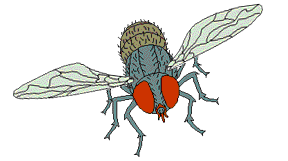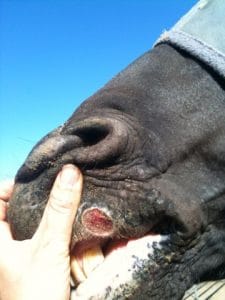 I love it when people make suggestions about topics for articles. It’s fun. I was asked about “Summer Sores” (aka, jack sores, and granular dermatitis, and probably a whole bunch of other names that I haven’t heard of). Since it’s summer, and these things can be a real pain, and they can also be somewhat disfiguring for affected horses, I figured I give you my take.
I love it when people make suggestions about topics for articles. It’s fun. I was asked about “Summer Sores” (aka, jack sores, and granular dermatitis, and probably a whole bunch of other names that I haven’t heard of). Since it’s summer, and these things can be a real pain, and they can also be somewhat disfiguring for affected horses, I figured I give you my take.
BUT… before we start, please understand that I’m giving you my experience, based on lots of reading and what I understand about the science. There’s lots of information out there about summer sores, and my experience shouldn’t be taken as a substitute for your own veterinarian’s advice. That said…
WHAT CAUSES A SUMMER SORE?

Electron microscopic view of a stomach worm
The primary culprit in the biological crime that is a Summer Sore is a small, otherwise relatively innocuous fly: a parasite called Habronema. Habronema is called a “stomach worm” because, well, the adult parasites live in the horse’s stomach (some attach to the stomach and some don’t). While having parasites in your stomach doesn’t sound like a lot of fun – certainly not for me, and probably not for most horses – stomach worms don’t seem to cause many problems in most circumstances (problems have been reported with heavy infestations).
Although life cycles are the things that parasitologists get all bleery-eyed over, for horse owning folk, the life cycle of Habronema is also important for understanding how horses get summer sores, so here goes. The adults live in the horse’s stomach (naming parasites is not necessarily the most creative endeavor). The adults lay eggs, which pass out in the manure. The eggs, as well as the larvae that develop from the eggs, are ingested by the larvae of house or stable flies (it’s a fly-eat-fly world out in the manure pit); the house or stable flies serve as intermediate hosts, that is, they pass along immature Habronema but they don’t get infested with them. Flies pass along the Habronema larvae to the horse – the horses either eat the flies (presumably by accident) or eat free Habronema larvae that have been left behind by flies on the horse’s lips.
 I apologize if this sounds disgusting. I mean, it kind of is, but it’s important. Mostly, this life cycle goes on without too much problem.
I apologize if this sounds disgusting. I mean, it kind of is, but it’s important. Mostly, this life cycle goes on without too much problem.
But… (isn’t it always something?)…
Sometimes the larvae apparently aren’t happy with their little life cycle (I say this a relative term – I’m fairly confident that no one has ever studies the happiness of Habronema larvae). When stable or house flies feed on wounds, or on moist areas such as the corner of the eye, or the lips, the larvae, unable to get themselves swallowed, end up migrating into the horse’s tissue.
Which is a problem, for both the larvae and the horse.
 WHAT IS A SUMMER SORE?
WHAT IS A SUMMER SORE?
When larvae migrate into horse tissue, it sets of an intense inflammatory reaction. This reaction – the “sore” as it were – is what people see and worry about (the “summer” part of “summer sores” comes, of course, because flies are most active in the summer). The sores are oozy and itchy and disgusting and they can have little yellow, hard material in them: like yellow grains of race. Rarely, you can even find larvae. When a summer sore occurs in, say, the horse’s mouth, or in the girth area, it’s more than annoying: it also makes it difficult to ride the horse. They can get surprisingly large, as well.
TREATMENT
The goals of treating summer sores are what you might expect: killing the parasite that causes the problem and taking care of the inflammation. As such, treatment often involves using dewormers (rightly or wrongly), especially ivermectin and moxidectin, in combination with anti-inflammatory agents, given both systemically (to the horse) and topically (on top of the sore). Topical medications for the treatment of summer sores can combine all sorts of glop, such as DMSO, antibiotics, and fly repellants. These concoctions mostly reflect the experience of the person prescribing the treatments.
CURIOUS ASIDE: Most deworming products have not been directly tested against most stomach worms. However, ivermectin and moxidectin have shown activity against some larvae.
 Here’s what you might not expect. In my experience, and also as written in the veterinary literature, worrying too much about killing the parasite may be mostly a waste of time. That’s because the inflammatory reaction set off the by the tissue is not only hard on the tissue (and ugly), it’s also hard on the parasites. In fact, the inflammatory reaction itself kills the little buggers. So, at least according to the literature – and this is supported by my own experience – spending a lot of time deworming affected horses, or applying deworming pastes, or products that contain deworming pastes, directly to the summer sores may not add that much – if it adds anything – to the treatment protocol. It certainly won’t hurt the horses – it’s just that it might not do much to help resolve the sores.
Here’s what you might not expect. In my experience, and also as written in the veterinary literature, worrying too much about killing the parasite may be mostly a waste of time. That’s because the inflammatory reaction set off the by the tissue is not only hard on the tissue (and ugly), it’s also hard on the parasites. In fact, the inflammatory reaction itself kills the little buggers. So, at least according to the literature – and this is supported by my own experience – spending a lot of time deworming affected horses, or applying deworming pastes, or products that contain deworming pastes, directly to the summer sores may not add that much – if it adds anything – to the treatment protocol. It certainly won’t hurt the horses – it’s just that it might not do much to help resolve the sores.
Surgery has been performed to remove the lesions in some cases, but I haven’t needed to do surgery on any of the cases that I’ve seen (again, this in my experience). People have treated them with things like liquid nitrogen, too. In my experience, what seems to be critical to get summer sores to resolve is the use of an anti-inflammatory medication: corticosteroids.
 It would be irresponsible of me to recommend particular doses or particular steroids for a horse that I can’t examine, but in my own practice, I’ve tended to use corticosteroids both systemically and topically. I tend to use dexamethasone as my “go to” corticosteroid systemically. For topical treatment, there are about a million ointments that contain corticosteroids, including ones that you can buy over-the-counter at the pharmacy. While I can’t recommend a particular dose, I can tell you that successful treatment usually takes weeks or even months. In my experience, when treatment doesn’t work, it’s usually because it hasn’t been done for long enough. One has to be dedicated and determined to get the things to resolve.
It would be irresponsible of me to recommend particular doses or particular steroids for a horse that I can’t examine, but in my own practice, I’ve tended to use corticosteroids both systemically and topically. I tend to use dexamethasone as my “go to” corticosteroid systemically. For topical treatment, there are about a million ointments that contain corticosteroids, including ones that you can buy over-the-counter at the pharmacy. While I can’t recommend a particular dose, I can tell you that successful treatment usually takes weeks or even months. In my experience, when treatment doesn’t work, it’s usually because it hasn’t been done for long enough. One has to be dedicated and determined to get the things to resolve.
ANOTHER ASIDE: I am aware of the concern about laminitis and corticosteroids. It’s still a question how much of a concern that really is. In my experience, judicious, long-term use of corticosteroids doesn’t cause horses any problems.
One other thing: even when treatment of summer sores has been successful, the lesions can come back. I have seen some horses develop summer sores in the same spots in consecutive years. This isn’t because of a failure of the medication and it isn’t because the lesions went dormant, rather, it’s because they got another summer sore in the same place. My guess is that the reason that they get the lesions in the same spots is that there are always flies, and individual horses are sensitive. Sometimes, medicine isn’t all that complicated.
 PREVENTION
PREVENTION
Given that flies are everywhere, it’s unrealistic to think that you’ll always be able to prevent summer sores in every horse. Still, there are some things that you might be able to do to help.
- Fly barriers – Masks, sheets, leg wraps, etc.
- Pick up manure as often as possible – To get rid of the fly’s favorite breeding material.
- Fly repellant – Systems, creams, sprays, etc. You have to use them frequently, but they can help, at least some.
There’s no guarantee that preventative measures will keep all horses from ever developing summer sores, but then, in a horse’s life – well, any life – what guarantees are there?
LASTLY
One other thing. Treatment of summer sores is time consuming and the sores themselves don’t heal quickly. The sores are ugly, annoying, and nasty-looking, but they do eventually go away. So, in addition to all of the other things, you also need a good dose of patience. Good luck!






